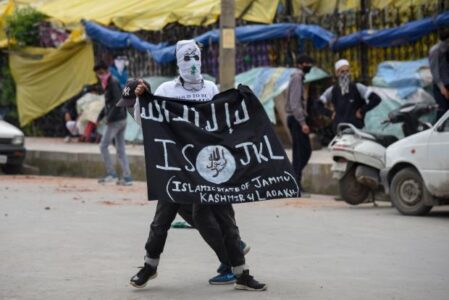
How to keep the Islamic State terrorist group down in 2022 and beyond
Last month, the U.S. military announced the end of its combat mission in Iraq and its transition to an “advise, assist, and enable” posture.
Yet while questions remain about the Biden administration’s commitment to allies’ security following the disastrous withdrawal from Afghanistan, for now the United States has not removed any of its 2,500 soldiers stationed in Iraq.
In fact, these troops are a key component of Iraqi security going forward, as reflected in military spokesman Yehia Rasool’s December 31 statement that his country still needs coalition forces to help fight the Islamic State (IS), “especially in the air force, air defense, army aviation, and intelligence system fields.”
As detailed in the author’s recent Washington Institute study Soldiers of End-Times: Assessing the Military Effectiveness of the Islamic State, coalition support for the Iraqi security forces and Kurdish-led Syrian Democratic Forces (SDF) was decisive in dismantling the IS “caliphate” and remains crucial for keeping the organization down.
The war against IS holds important lessons for the U.S. military on how best to combat jihadist groups and work “by, with, and through” regional allies.
Islamic State has proven to be a particularly adaptable enemy, and fighting it and other jihadist elements in the long term will require matching their creativity. There is much the United States can do to stay ahead.
Fostering a culture of innovation. IS exhibited a high level of innovation that the coalition was slow to match.
The group pioneered large-scale use of small drones as explosive delivery platforms and realtime intelligence-gathering assets, a practice emulated by the United States, China, Russia, Iran, and Turkey, among others.
Similarly, its unanticipated mass use of suicide car bombs in certain battle zones proved especially devastating to defending forces. Such innovations derived from three main factors:
-The group’s apocalyptic ideological imperative to quickly conquer large territories, which necessitated strong military capabilities
-The frequent need to fight materially superior foes, which fostered creative asymmetric measures
-A willingness to sustain substantial casualties, which gave IS more leeway to experiment with tactics like suicide bombing
The United States and partner forces can foster innovative thinking and tactics of their own through greater integration of advanced technology. For example, coalition forces have periodically employed cyberwarfare to support Iraqi and SDF operations, while the limited use of coalition jammers has helped counter IS drones.
U.S. forces have every reason to continue integrating these capabilities into counterterrorism operations. Besides presenting little if any added risk to coalition personnel, such efforts could bolster partners and enable forces to exercise new technologies and tactics.
The latter benefit could be particularly useful as the United States seeks innovative ways of competing with China and Russia, not to mention deterring malign actors such as Iran and its proxies.
Deepening relations with partners. The most aggressive, motivated, flexible, and risk-tolerant U.S. partner against IS remains the Iraqi Counter Terrorism Service (CTS). The unit’s long, close relationship with U.S. Special Operations Forces facilitated its quick, albeit painful, adaptation from counterterrorism to conventional warfare.
Now with IS in an insurgent posture, the CTS has adeptly reprised its counterterrorism role. Yet the force is still overused, while the Iraqi army suffers persistent difficulties.
A similar pattern emerged in Syria, where the coalition supported the SDF’s transition to a force capable of defeating IS on the battlefield and now continues to help advance its counterterrorism capabilities. Going forward, the United States must deepen these relationships to develop more robust counterterrorism capabilities.
Leveraging lighter technologies. Just as IS used over-the-counter drones and simple vehicles for some of its most damaging weapons, the coalition can provide partners with similar low-cost assets.
Less-sophisticated quadcopters are increasingly common in advanced militaries and can be useful against jihadists. Simple remote-controlled ground vehicles could emulate the effects of suicide bombs or help protect friendly forces from them.
Weapons designed to counter drones and light vehicles—such as jammers, shoulder-launched rockets, and disruptive energy beams—offer another relatively cheap and user-friendly way to boost partner readiness for jihadist threats. This is particularly true in cases where forces have yet to acquire or develop indigenous sophisticated weaponry, as with the SDF.
Improving information operations. IS effectively used an extensive media apparatus to intimidate its adversaries, spur recruitment, inflame its supporters, and discredit the coalition.
The United States and its partners were mostly on the defensive in the information space, reacting too slowly through a cumbersome response mechanism. In contrast, IS disseminated a steady stream of social media posts, articles, videos, and other material to its many followers, frequently portraying coalition forces as weak and uncaring for civilian life.
The dearth of significant coalition responses allowed the group to operate almost unopposed in the information space, especially amplifying its claims when they received mainstream media attention. Taken together, these efforts put a damper on the coalition’s operations and planning, at times diverting its attention from prosecuting the war to reassuring supporters.
This is a dangerous deficiency that the United States must invest in correcting if it hopes to defuse jihadist threats in the future.
Authorities and procedures need to change in order to streamline communications, and coalition forces require more media-savvy operators who are able to gather and share information in near realtime.
This is a particularly important task now that the U.S. military faces increasing domestic media scrutiny of its conduct during the war against IS.
Source: Washington Institute





